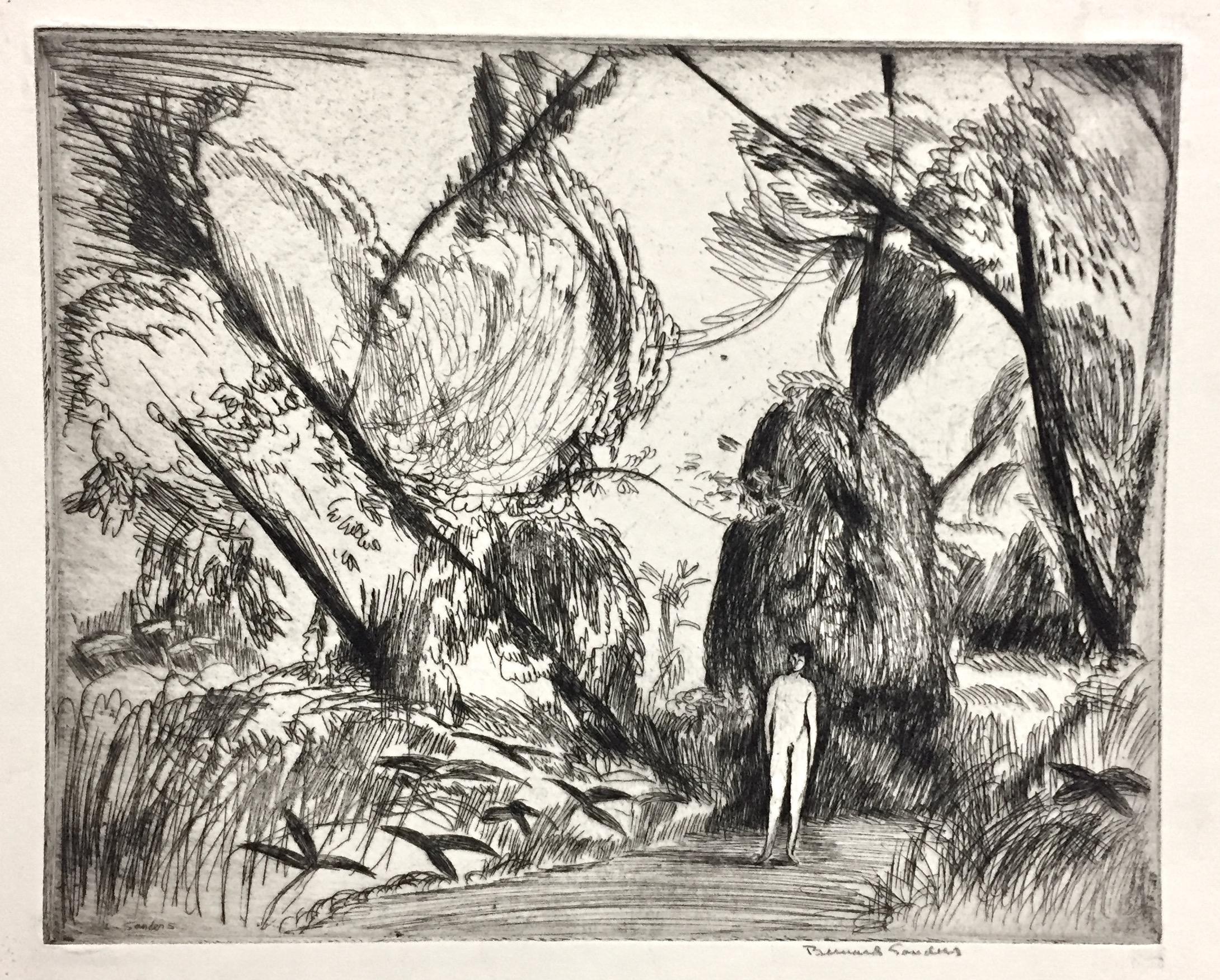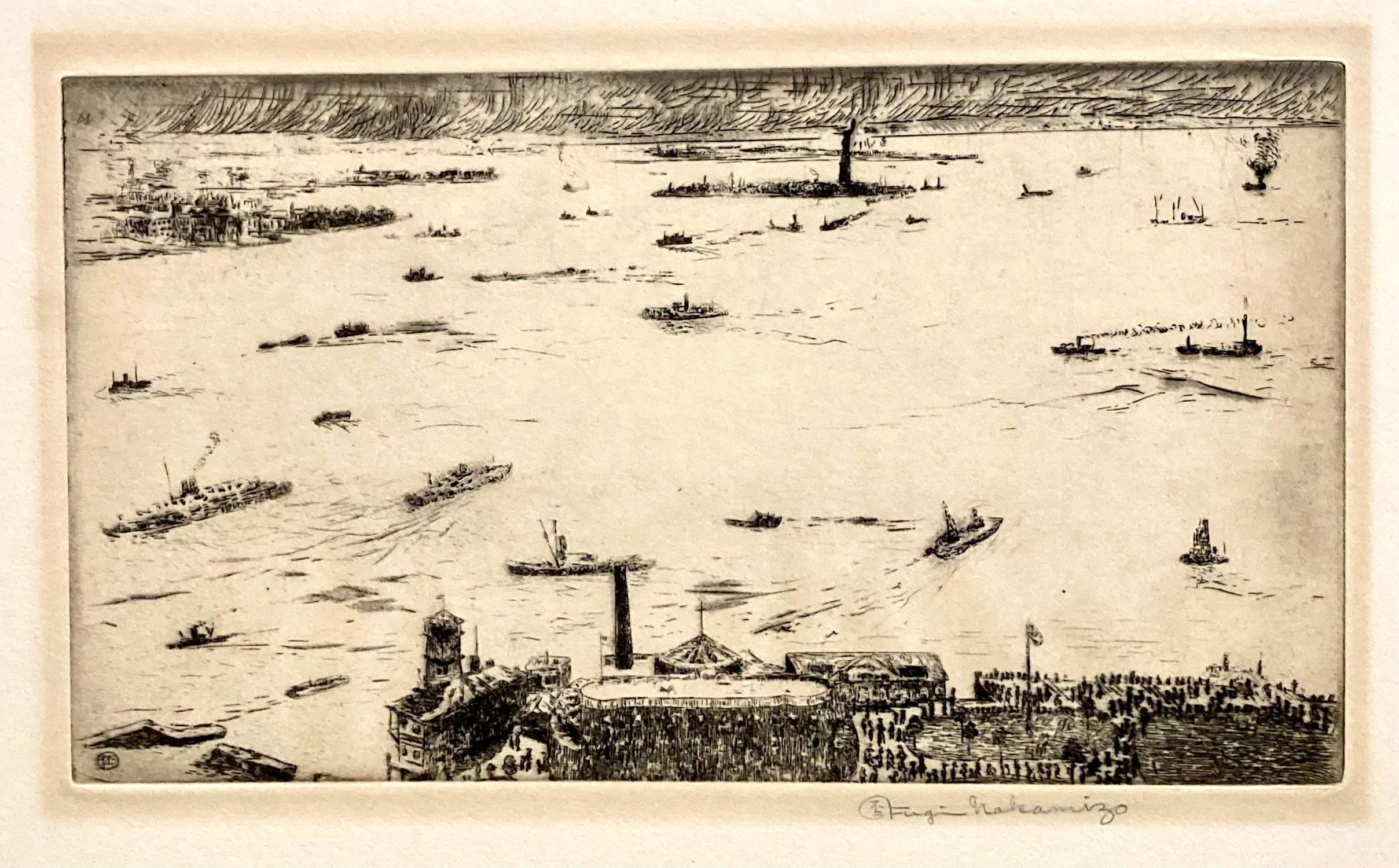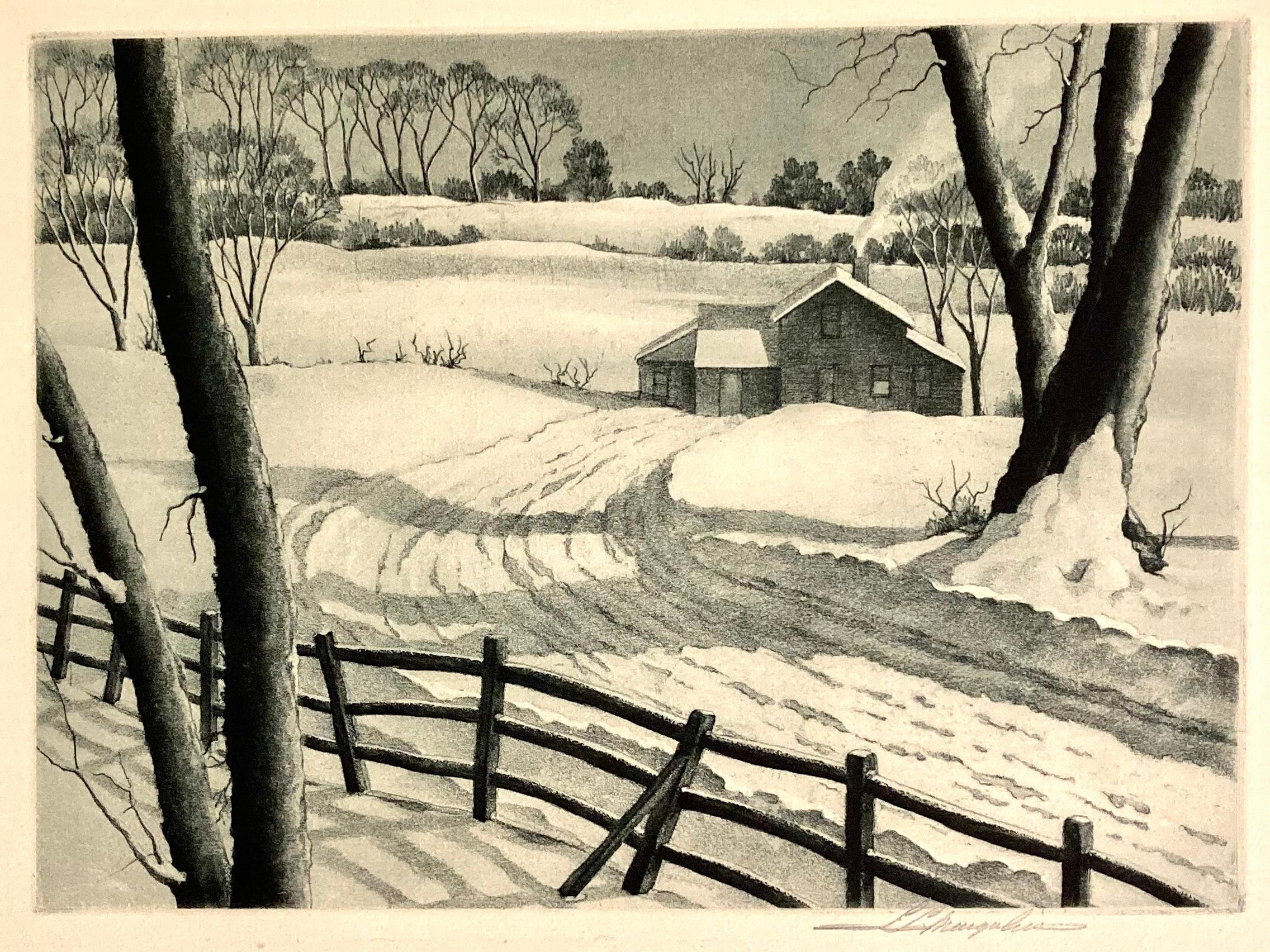Items Similar to Dark House
Want more images or videos?
Request additional images or videos from the seller
1 of 8
Earl HorterDark House1937
1937
About the Item
Dark House is a soft-ground etching with aquatint signed in pencil by the artist. This image is in the collection of the Detroit Institute of the Arts
Printmaker Earl Horter, born in 1881 in Germantown, Pennsylvania, was known for his realistic etchings and aquatints of urban scenes, though he was also an illustrator and painter. As a teenager, he engraved stock certificates. He was essentially self-taught, though he did take an etching class when he moved to New York City in 1903 to work for an advertising agency. Horter had a one-man show in 1916 in New York City at the Frederick Keppel and Company gallery. He was given the exhibition by Carl Zigrosser, later the first Curator of Prints and Drawings at the Museum of Modern Art. Horter was back in Philadelphia in 1917, where he would remain until his death in 1940. He worked there as art director for the N. W. Ayer advertising firm from 1917-1923.
Horter was a member of the Society of Illustrators. He exhibited at the Pan American Exposition in 1915 in San Francisco, California; the Art Institute of Chicago, Illinois; and the Philadelphia Print Club's National Exhibition of Prints; as well as Corcoran Gallery biennials from 1935 to 1939, in Washington, D.C. Horter is listed in "Mantle Fielding's Dictionary of American Artists"; "Who Was Who in American Art"; and Mallett's "Index of Artists".
Though not a man of extraordinary means, Horter was a lover of modernist art, which he gradually purchased, creating an important collection, well ahead of its time in America, of Cubist and Precisionist works, as well as African sculpture and Native American artifacts. Artists Horter collected include Europeans Picasso, Braque, Duchamp and Brancusi, and Americans Charles Sheeler and Arthur B. Carles. He was a friend of Carles, as well as other artists and collectors such as Leopold Stokowski, conductor of the Philadelphia Orchestra; Franklin Watkins; S. S. White; and Carroll Tyson.
Horter turned a Philadelphia brownstone into a studio and gallery to house his collection, aided by Paul Cret, the designer of the The Barnes Foundation and Rodin Museum. By 1931, the artist would begin selling his collection due to financial need brought about by the Depression.
Horter was also a teacher in Philadelphia at the Stella Elkins Tyler School of Art; Graphic Sketch Club (now the Fleisher Art Memorial); and the Philadelphia Museum School of Industrial Art (now the University of the Arts).
In 1998, the Philadelphia Museum of Art put on an exhibition, Mad for Modernism: Earl Horter and His Collection, assembling once again many of the major works of art that comprised the artist's collection. In 1934, the Museum, then called the Pennsylvania Museum, had previously exhibited Horter's collection, though some of the works had already been sold.
Several of Earl Horter's prints are in the collection of Georgetown University, in Washington, D.C.
- Creator:Earl Horter (1881 - 1940, American)
- Creation Year:1937
- Dimensions:Height: 10.44 in (26.52 cm)Width: 10.75 in (27.31 cm)
- Medium:
- Movement & Style:
- Period:
- Condition:
- Gallery Location:New Orleans, LA
- Reference Number:1stDibs: LU84135611801
About the Seller
4.9
Gold Seller
These expertly vetted sellers are highly rated and consistently exceed customer expectations.
Established in 1988
1stDibs seller since 2018
752 sales on 1stDibs
Typical response time: 3 hours
Associations
International Fine Print Dealers Association
- ShippingRetrieving quote...Ships From: New Orleans, LA
- Return PolicyA return for this item may be initiated within 14 days of delivery.
More From This SellerView All
- Sanctuary (St. Anthony's Garden at rear of St. Louis Cathedral on Royal Street)By Frederick MershimerLocated in New Orleans, LAThis French Quarter garden is a serene haven with a lighted statue of Christ that exists not very far from the raucous revelry of New Orleans' Bourbon S...Category
1990s American Modern Landscape Prints
MaterialsMezzotint, Aquatint
- Puerta del Obispo ( Romanesque Spanish Cathedral)By John Taylor ArmsLocated in New Orleans, LAThis image is by America's greatest etcher, John Taylor Arms. The Spanish cathedral in Zamora is an impressive example of Romanesque architecture located on the hilltop by the river ...Category
1930s American Modern Landscape Prints
MaterialsEtching
- Rooftops (the harbor and skyline of NYC from Brooklyn rooftop)By Frederick MershimerLocated in New Orleans, LAMoody, mysterious, majestic – these are some of the ways to describe the mezzotints of Frederick Mershimer. His images travel through the serenity of a Brooklyn neighborhood on a sti...Category
Early 20th Century American Modern Landscape Prints
MaterialsMezzotint, Aquatint
- La Colegiata Toro (Romanesque Santa Maria la Mayor/Zamora province Spain)By John Taylor ArmsLocated in New Orleans, LAJohn Taylor Arms created this superb architectural image of La Colegiata in 1935 in an edition of 153. It is #12 in his Spanish Churches series and is referenced as Fletcher #284. One of the most characteristic examples of transitional Romanesque architecture in Spain, the church of Santa María la Mayor is inspired by the Cathedral of Zamora, in turn inspired by the Old Cathedral of Salamanca. The tower-dome is usually listed as one of the four most typical in León together with those in the cathedrals of Salamanca, Plasencia and Zamora. The church was begun around 1170, and was finished in the mid-13th century. Two different directors of the work have been identified, according to the different types of stone used (limestone in the old sections, sandstone in the most recent ones), and by the barrel vaults...Category
1930s American Modern Landscape Prints
MaterialsEtching
- Restaurant in Mott StreetBy Charles Frederick William MielatzLocated in New Orleans, LAThe image depicts a restaurant on New York's Mott Street with ornamental iron work on the balconies. There are six figures in the scene in various stages of contrast. Mott Street is considered the unofficial Main Street of New York's Chinatown. Ella Fitzgerald sang it best: “And tell me what street compares with Mott Street in July? Sweet pushcarts gently gliding by.” CFW Mielatz was an early influence on the drypoints and etchings of Martin Lewis. This piece was created in 1906 and it is signed in pencil. It is part of the collection of New York's Metropolitan Museum of Art C.F.W. Mielatz American, 1860-1919 Born in Bredding, Germany in 1864, Mielatz emigrated to the United States as a young boy and studied at the Chicago School of Design. Mostly self-taught, his first prints were large New England landscapes reminiscent of the painter-etcher school of American Art. Around 1890 he started to produce prints of New York City and by the time of his death, the number totaled over ninety images. He was a master technician in the field of etching, reworking many of his plates to get the exact feeling he was seeking. Mielatz was a member of the New York Etching...Category
Early 20th Century American Modern Landscape Prints
MaterialsEtching, Drypoint
- Waiting For My Train(track crossings that create Chicago EL / Merchandise Mart)By Martin LevineLocated in New Orleans, LAWaiting for my Train is #55 from edition of 100. "Waiting for my train" is the stop right before the tracks cross, and create Chicago's famous "Loop", on the above ground EL. The M...Category
1980s American Modern Landscape Prints
MaterialsEtching, Aquatint
You May Also Like
- Bernard Sanders, Boy in the woodsLocated in New York, NYThere's so often a mysterious or evocative atmosphere that permeates Sander's work. Signed in pencil; titled in lower margin in pencil.Category
Early 20th Century American Modern Landscape Prints
MaterialsEtching
- Donald Shaw MacLaughlan, A Tuscan FarmBy Donald Shaw MacLaughlanLocated in New York, NYDonald Shaw MacLaughlan's small, even 'miniaturist' etching, 'A Tuscan Farm,' features an idyllic view of a scene he would have encountered on his European travels. MacLaughlan was a...Category
Early 1900s American Modern Landscape Prints
MaterialsEtching
- Irving Guyer, Christmas Trees on Second Street (NYC)By Irving GuyerLocated in New York, NYPhiladelphia-born Irving Guyer attended the Art Students League and worked in New York City before moving to California. This print is signed and titled i...Category
1930s American Modern Figurative Prints
MaterialsDrypoint, Etching
- Kent Hagerman, (US Air Force Fairchild C-119, the 'Flying Boxcar')By Kent HagermanLocated in New York, NYWhile this is probably a military airport, Kent Hagerman still shows it at its futuristic best. Hagerman was an amazing draftsman who managed to get fantastic detail into his work. This is really a portrait of a plane -- the Fairchild C-119. The words 'United States Air Force' on the side of the plane date it to 1947 or later, after the Air Force split from the Army. The design featured the 'twin boom' clearly showing in this etching. Thanks to this feature it was called the Flying Boxcar. About 1100 were built and used until 1955. It was also used by the Chinese Air...Category
Mid-20th Century American Modern Figurative Prints
MaterialsEtching
- Fugi Nakamizo, New York Harbor from the BatteryLocated in New York, NYJapanese born, Fugi Nakamizo came to New York City in 1910. He studied at the Art Students League and Cooper Union, NYC, and also printmaking with Joseph Pennell. He worked on the Federal Public Works of Art Project in the 1930s and in the 40s, during WWII, was interned at the Japanese-American internment camp in Topaz, Utah. His work is in the permanent collections of the Metropolitan Museum of Art and the Brooklyn Museum of Art, NYC, and the Library of Congress and Smithsonian Institution, Washington, DC. This etching of New York...Category
1920s American Modern Figurative Prints
MaterialsEtching
- S. L Margolies, Silent SymphonyLocated in New York, NYS. L Margolies (Samuel L.) made dynamic urban views and calm country scenes. This peaceful subject, with snow-covered hills and tidy cabin, Silent Symphony, 1946, marks an end to the...Category
Mid-20th Century American Modern Landscape Prints
MaterialsEtching
Recently Viewed
View AllMore Ways To Browse
Dark Vintage
Vintage European House
Modernist House
Vintage Industrial House
Earl Brown
Native American Designers
Industrial Etchings
White Cubist Sculpture
Etching Aquatint House
Native American Etchings
Barnes Foundation
Picasso Exposition
Georgetown University
1930 Pencil Sketches
Rodin Print
American Mantle
1940pencil Sketches
Earl Washington




